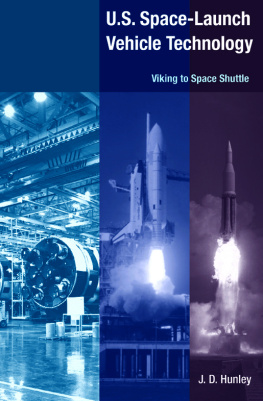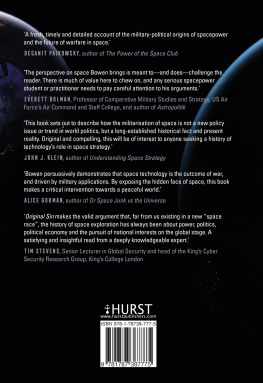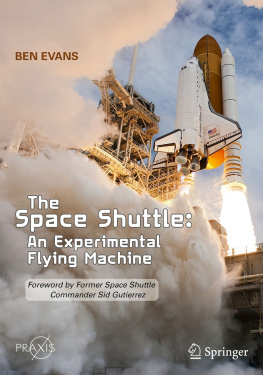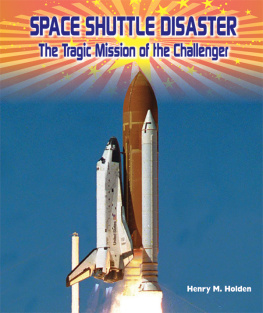
Florida Aamp;M University, Tallahassee
Florida Atlantic University, Boca Raton
Florida Gulf Coast University, Ft. Myers
Florida International University, Miami
Florida State University, Tallahassee
New College of Florida, Sarasota
University of Central Florida, Orlando
University of Florida, Gainesville
University of North Florida, Jacksonville
University of South Florida, Tampa
University of West Florida, Pensacola
- Copyright 2008 by J. D. Hunley
- Printed in the United States of America on acid-free paper
- All rights reserved
- 13 12 11 10 09 08 6 5 4 3 2 1
- Library of Congress Cataloging-in-Publication Data
- Hunley, J. D.,1941
- U.S. space-launch vehicle technology: Viking to Space Shuttle/J.D. Hunley.
- p. cm.
- Includes bibliographical references and index.
- ISBN 9870813031781 (alk. paper); ISBN 9780813038568 (e-book)
- 1. Launch vehicles (Astronautics)United StatesHistory
- 20th century. 2. RocketryUnited StatesHistory.
- 3. Space shuttlesUnited StatesHistory. I. Title.
- TL785.8. L3H87 2008
- 629.4709739dc22 2007042544
- The University Press of Florida is the scholarly publishing agency for the
- State University System of Florida, comprising Florida A&M University,
- Florida Atlantic University, Florida Gulf Coast University, Florida
- International University, Florida State University, New College of Florida,
- University of Central Florida, University of Florida, University of North
- Florida, University of South Florida, and University of West Florida.
- University Press of Florida.
- 15 Northwest th Street
- Gainesville, FL 326112079
- http://www.upf.com
Dedication
(p.v) This book is dedicated to Barnet R. Adelman, Wilbur Andrepont,
Charles Bartley, Robert C. Corley, Daniel Dembrow, Ross Felix,
Robert L. Geisler, Edward N. Hall, Charles Henderson, Kenneth W. Iliff,
Karl Klager, Franklin H. Knemeyer, Grayson Merrill, Ray Miller,
Edward W. Price, Milt Rosen, Ed Saltzman, Ronald L. Simmons,
Ernst Stuhlinger, H. L. Thackwell, and Robert C. Truax. (p.vi)
(p.ix) Preface and Acknowledgments
This book and the volume that precedes it, Preludes to U.S. Space-Launch Vehicle Technology: Goddard Rockets to Minuteman III, address a significant gap in the literature about access to space. There are numerous and quite excellent volumes covering various aspects of missile and space-launch-vehicle development and some general accounts. But there is no study that traces in a detailed and systematic way how the technology evolved from its beginnings with Robert Goddard and the German V-2 missile to the end of the cold war.
Another problem with the existing literature is the lack of agreement among sources about specifics. From measurements of length and diameter to those of thrust and accuracy, sources differ. These two books cannot claim to resolve the differences, but together they do acknowledge them in endnotes and indicate which sources seem most credible.
I first began working on these histories in 1992 when I undertook a much more modest, monographic study comparing the contributions to U.S. launch-vehicle technology of the Wernher von Braun group that developed the V-2 in Germany and then immigrated to America after World War II with those of the group around Theodore von Krmn and Frank Malina at the Jet Propulsion Laboratory near Pasadena, California. I quickly found that the literature would not permit such a comparison without a much broader assessment of rocket technology, which I now provide.
Because the material to be covered is so broad as well as technical, what I had originally conceived as a single volume had to be divided into two separate books. The first book, Preludes to U.S. Space-Launch Vehicle Technology, covers primarily missile development, because many of the launch vehicles borrowed technology and whole rocket stages from missiles, most of which developed before the launch vehicles. In a couple of cases, to provide continuity of coverage, early uses of missiles as components of launch (p.x) vehicles are discussed in Preludes to U.S. Space-Launch Vehicle Technology. Then Viking to Space Shuttle steps back in time to pick up development of Viking and Vanguard, which preceded most of early missile production. This second book then continues with the Thor-Delta, Delta, Atlas, Scout, Saturn, and Titan space-launch vehicles, concluding with treatment of the space shuttle. Both books are written in such a way that they can be understood by a general audience, but I hope they will also prove useful to scholars, engineers, and others who already possess an extensive knowledge of at least some of the material covered.
Although the two books constitute a continuous whole, intended to be read as such, some readers primarily interested in either missiles or launch vehicles may want to read just one of the volumes. They will find much that is new in each. But readers primarily interested in missiles should be aware that I have not written a complete history of even the ballistic missiles that Preludes to U.S. Space-Launch Vehicle Technology mainly covers, while providing only limited treatment of some tactical missiles. Since my focus is on the technologies that contributed to launch-vehicle development, I spend comparative little time with the business end of missiles, the warheads. Instead, I concentrate on propulsion, structures, and guidance-and-control technologies because these carried overthough often with considerable modificationto launch vehicles.
By the same token, those primarily interested in launch-vehicle technology will find that they will miss out on much of the history by starting with Viking to Space Shuttle. It is obviously impossible to understand the Thor-Delta family of launch vehicles without knowledge of the Thor missile or the Atlas launch vehicles without knowing how the Atlas missile developed. Links between the Titan I and II missiles and the Titan launch vehicles are equally important. Even the Scout and Saturn launch vehicles borrowed much technology from missiles. And the solid rocket motors for the Titan III and IV as well as the solid rocket boosters for the space shuttle borrowed much technology from the Polaris and Minuteman missiles.
In researching and writing both volumes, I have incurred many debts of gratitude to an enormous number of people. I acknowledge many of them in endnotes, but unfortunately I can no longer remember everyone who assisted me in a great variety of ways. I owe particular gratitude to Roger Launius, who, as my boss at the NASA History Office, first encouraged me to begin studying the subject of rocket technology and has provided unfailing support in more ways than I can recount. (He also was wise enough to discourage me from attempting to cover the entire gamut of American missile (p.xi) and launch-vehicle technology, but I was not smart enough to follow that advice.) Lee Saegesser and Jane Odom, archivists at the NASA History Office, both provided extensive support, as have the rest of the archival staff there, including Colin Fries and John Hargenraether as well as their predecessors, Jennifer and Bill Skeritt.
After I was fortunate enough to become the Ramsey Fellow at the Smithsonian National Air and Space Museum, Mike Neufeld kindly read several chapters and offered me his criticism. Many of his colleagues at the museum, along with the archival staff, were also extremely helpful. I had valuable discussions with John Anderson, Paul Ceruzzi, Tom Crouch, David DeVorkin, Peter Jakab, Mike Neufeld, and Frank Winter about aspects of my work. Also very helpful were a host of archivists, librarians, curators, docents, and volunteers including Marilyn Graskowiak, Dan Hagedorn, Gregg Herken, Peter Jakab, Mark Kahn, Daniel Lednicer, Brian Nicklas, George Schnitzer, Leah Smith, Paul Silbermann, Larry Wilson, and Howard S. Wolko. I am thus very grateful to NASM for granting me the fellowship and thereby allowing me to complete my research for this book in addition to obtaining the assistance of all of these individuals.






